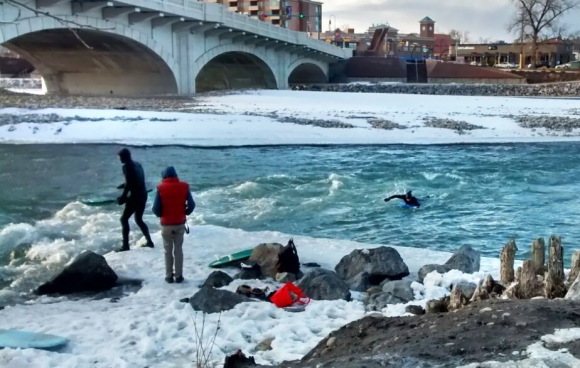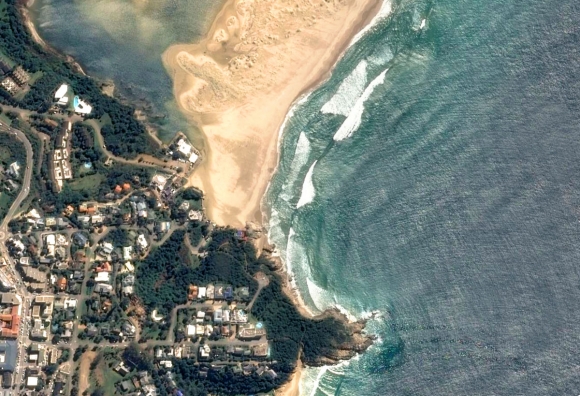
Rock, Paper, Scissors
Monday 2 March 2015 Surf breaks can come and go in unexpected places, such as on a river in Calgary below 10th Street. Spike looked at the fickle nature of wave mechanics. Photos from Canada by Louise Murdoch.
{youtube}u_xzOSWSUPg{/youtube}
Discovered by local surfer Jeff Brooks in 2005, the 10th Street standing wave on the Bow River in Calgary, Canada, led to the formation of the Alberta River Surfing Association (ARSA) by like-minded river riders.
However, soon after ARSA formed, the rocks on which the wave broke shifted, and it was gone. Eight long years went by. Minutes at ARSA meetings must have been minimal. There were other rivers to explore and surf of course: remote spots with only grizzlies and salmon to keep you company.
But in June 2013, strong-flowing flood waters surged down the river to create a channel, and the wave came back. Surfers changed their local from the pub back to their surf spot, a chilly little peeler that required a deft hop off the river bank straight onto your board, sometimes off chunks of ice.

Everyone knows that surf spots come and go. Well, surfers do. Obviously, some breaks are locked into perpetuity by the solid foundation of a geological feature, such as slabs of granite or basalt formed eons ago. Read Jeffreys Bay, Outer Kom and Queensberry Bay.
Rocks are movable, given sufficient water movement. A strong flow of water can move just about anything that is movable. Remember the storm surge and giant swell of 2007 that rearranged the KZN shoreline? Sand on the other hand, requires much less force.
Sand-bottomed waves are in a constant state of flux as near-shore currents surge and swirl, shunting sand particles backwards, forwards and sideways. Without natural or man-made objects, such as piers or breakwaters, to focus the sand onto sandbanks where waves break, these spots are fussy.

Sand-bottom waves vary in quality. Llandudno in Cape Town, for instance, oscillates between marginal and world class, depending on where the sand is. A spot like New Pier has a combination of littoral drift (inshore currents) and the eddies around a pier to help focus the sand into the right place. Even then, it can suffer bouts of unreliability.
Other surf spots can disappear for extended periods of time, like 10th Street did.
Who remembers the death of Mdumbe, on the Eastern Province's Wild Coast? Flood waters washed the sand away from the point, gouging a massive hole, and killing the wave. Sometimes nature's ability to regenerate - to kickstart that hefty bid for momentum - is diminished by the extremity of the event. It took an age for the sand to return. Was it 10 years? Seemed like it. Now it's a proper wave again.
Inversely, spots can be created by a sudden influx of sand, when a strong flow of water transports the sand to an area. These spots - usually referred to as superbanks - magically appear, but disappear just as quickly. They break with sublime form for a finite period, before nature redresses the imbalance, sometimes taking days; maybe weeks. If you're lucky, it sticks around for months.

Perhaps the most famous recent examples in South Africa were the right-breaking superbank at Lookout Beach in Plettenberg Bay (see above Google Earth satellite image taken as the sand returns to the beach and the superbank loses its foundation) and the short-lived lefthand tubes that ran along a superbank after it formed at the mouth of the Bot River between Kleinmond and Hermanus (see below showing the potential for a superbank).
In both instances, the waves were legendary: peeling tubes running with symmetrical precision as the swells curled along the edge of a rimmed line of sand.
Lookout Beach was created by a huge flood that tore the beach apart, ripping through the carpark and pushing the beach sand out to sea, the flow of the current spreading the sand in a steep shelving formation, a rimmed sandbank consistently shallow on one side, and consistently deep on the other. The sand has almost returned to normal now, alhough on the right swell and tide, the superbank shows a glimmer of its former glory.

The Bot river bank - created by exactly the same phenomenon (floodwaters pushing sand out of a lagoon mouth and depositing it in a long line beneficial to prevailing swell directions) - vanished soon after it began.
People still talk about how perfect those waves were. Local surfers between Hermanus and Gansbaai had the wave to themselves. They totally lucked into perfect rolling tubes that went on for hundreds of metres. By the time the news broke, the pendulum had swung and the bank was breaking up.
We don't have to amend the surfing cliche: "You should have been here yesterday" but the other one requires a tweak: "It will be better, not tomorrow ... but maybe in about 12 years".


